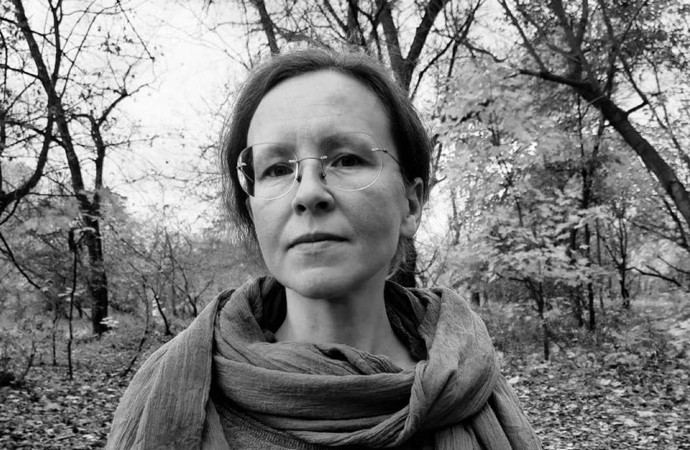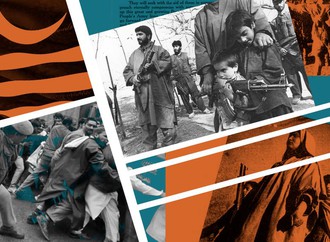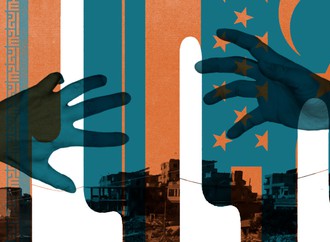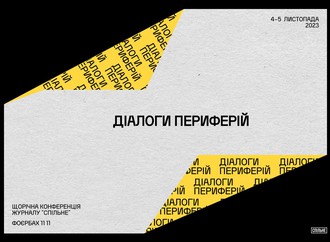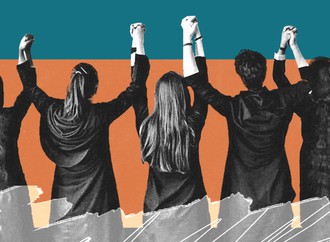Frieda Afary is an Iranian American socialist feminist activist, translator and writer. She is a public librarian in Los Angeles. In 2022 her book “Socialist Feminism: A New Approach” was published by Pluto Press. In this work, she critically evaluates various articulations of socialist feminism and why it is needed to fight the global rise of authoritarianism and fascism. Frieda is closely following the events in Iran and has organized numerous discussions and publications to support the feminist and anti-authoritarian uprising in the country. She has also organized solidarity events and publications opposing the Russian invasion in Ukraine, and promoting the cause of Ukrainian resistance.
In the first part of this interview, she gives an extensive historical and structural explanation of how Islamic fundamentalists came into power in Iran, including a critical evaluation of the role which Iranian leftists played in this by being focused exclusively on opposing Western imperialism. In the second part of the interview Frieda speaks about the most recent feminist and anti-authoritarian uprising in the country as well as the Russian invasion of Ukraine and the challenges for the global progressive movements.
There have been those pictures from Iran in the early 60s and 70s, circulating in social media, capturing women in universities, at the workplace and on the streets with uncovered heads and modern outfits. The contrast with the situation in Iran, established after the Islamic Revolution, is striking and those pictures are presented to capture that contrast. To what extent were those emancipated women mirroring the real situation of women in 60s and early 70s in Iran?
In the first half of the 20st century we saw the emergence of modernization in Iran, but with the exception of the short lasting 1906-1911 Constitutional Revolution, it was modernization from above, based on authoritarianism. Starting from the 1920s the new king of Iran, Reza Pahlavi, thought of himself as the Iranian version of Ataturk. There were some openings in education, and women's education too. He also imposed mandatory removal of the hijab. There were police officers who would go around and force women to remove their hijab. Pahlavi wanted women to look modern, and he didn’t want Iran to look backward in front of the West. There was state-capitalist industrialization. Iran was partially occupied during World War II by the Allies because the king had Nazi sympathies. The Allies exiled him and put his son, Mohammad Reza Pahlavi in power.

Iranian women pose under the "Miller's Beautiful Wife" movie poster. Tehran, 1956. Photo: from open sources
There were some political openings in the 1940s. The USSR was also very influential in that period in affecting the minds of intellectuals. Stalin had an unhappily great impact on Iranian intellectuals. He must be known as having a horrible ideology and authoritarian system based on state capitalism and domination. But in Iran Stalin had supporters because of his opposition to Western capitalism, and many-many intellectuals became Stalinists.
In the 1950s Iranian Prime Minister Mohammad Mosaddegh nationalized the oil industry. He also wanted modernization, but he was critical of the monarchical system. In 1953, he was overthrown in a coup that was backed by the United States. The coup was also backed locally by the Islamic fundamentalists who were against any efforts to create civil rights and freedoms for women, and also against some of the efforts of modernization. Without the support of Islamic fundamentalists, the coup against Mosaddegh would not have succeeded.
The Shah, Mohammad Reza Pahlavi came back, and Mosaddegh was put under house arrest inside the country for the rest of his life. After the 1953 coup we saw the continuation of modernization from above, but without the political openings that existed in the 1940s. Iran became part of that wave of economic growth that we saw in the world after World War II. As far as women were concerned, women's rights activists were pushing for some basic rights regarding marriage, divorce, child custody and inheritance.
By the early 70s Iran did have a modest family protection law that gave women some rights in relationship to divorce and child custody. The Islamic fundamentalists were very much opposed to that. In general however, basic political freedoms were repressed. There were book bans, and there were political prisoners: Young people would be sent to prison for reading banned books, or having any type of meeting or discussion, that opposed the monarchy. Regarding hijab, the authorities did not enforce the removal of the hijab. You had the right to wear the hijab or not, and you would not be arrested for one or the other. And women were able to work, go to school or university.

One of the Iranian photo models, 1971. Photo: from open sources
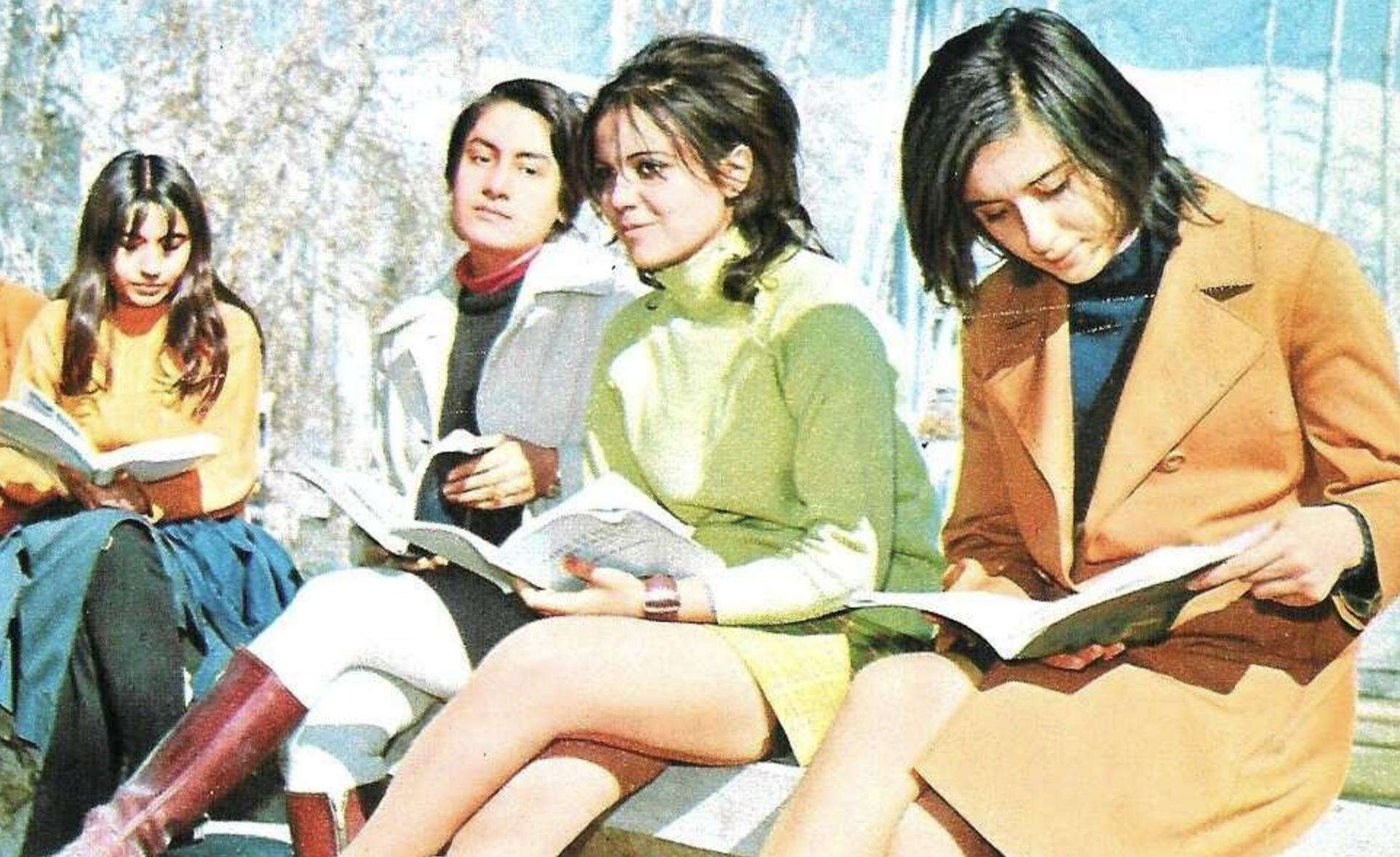
Iranian students, 1970s. Photo: from open sources
At the same time there was another important social change in the country: the Shah's administration imposed a very modest land reform program. The Islamic fundamentalists were against the land reform, even as modest as it was, and they were against any changes that gave women any rights.
This effort of land reform didn't end up giving land to the peasants. But what happened was that the peasants were then forced off the land, and came to the cities, and became construction workers, and manual laborers. They also became victims of the propaganda of Islamic fundamentalists. Peasants were coming into the cities, having lost whatever arrangements they had on the land in the feudal system, and being exposed to the Islamic fundamentalists’ propaganda and seeing the class differences, having to live in shanty towns, having no rights. This class division, the fact that the peasants were coming into the cities and were homeless, and all these contradictions between the forced modernization from above, and the actual situation on the ground — it all created the conditions for Revolution. It also created the conditions for the Islamic fundamentalists to have a mass audience. The Islamic fundamentalists were saying that they were against the monarchy, and they were against this type of modernization - giving too many rights to women. They were against the mixing of people from different religious minorities. They were definitely against the Baha'i religious minority in Iran, and very anti-semitic.
When the Revolution against the monarchy started in 1978-1979, we had the student youth, who were mostly following Stalinism or Maoism, and we had the Islamic fundamentalists appealing to the masses, calling for Islamic values and at the same time calling for social justice. They were building on the fact that there was so much class inequality in Iran. Once the labor strikes became widespread and the Revolution overthrew the monarchy, the Islamic fundamentalists were able to gain the upper hand, both because they did have a mass force, and also because the intellectuals, who were influenced by Stalinism and Maoism, were so focused only on being against US imperialism. Most leftist and nationalist intellectuals thought that they could make an alliance with the religious fundamentalists to get rid of the king, and then gain power.
To return to your question about the modern looking pictures of women from the late 1960s and 1970s, in that period, we had some women coming out with the modern outfits that you saw in those pictures, mostly urban and middle or upper class. Although some working-class women too, if they wanted to, and if their families let them, would get out without the hijab. And we also had a lot of contradictions at the various levels of society. On this question, and several others, I would highly recommend the book "Sexual politics in modern Iran", written by Janet Afary, my sister. She goes into detail on the process of modernization, and all the contradictions within it.
What was the course of women’s resistance after the 1979 Iranian Revolution and why did it fail? Were there any struggles at the later stages? And can one track the roots of the current uprising in those pre-revolution landscapes and early post-revolution struggles?
After the revolution overthrew the Pahlavi monarchy in February 1979, one of the first signs of the counter-revolution was the order by Ayatollah Khomeini that women should wear the hijab in government offices. There was a very important demonstration of women on March 8 of 1979. These were women who had been part of the revolution, and many of them were leftist women, who were chanting: "We didn't make a revolution to go backward". And they understood that this order to wear the hijab was the sign of many worse things to come. A small part of the Iranian left supported these women at first, and there were even some leftist men, who came to their demonstration and protected women against the attacks by Islamic fundamentalists. But even that small part of the left that supported the women's demonstrations, told them after a couple of days: "You know, you should stop this because this is really taking attention away from the main goal of the struggle, which is fighting US imperialism". That was a real setback when those women were told to go back home, and they did not get the support that they needed. And the latest “Woman, Life, Freedom” movement do identify themselves as the continuators of those women’s efforts. They are proud of the women who came out at that time and protested against the mandatory hijab.
What happened then? There was the assault on women and assault on the rights of the Kurdish minority, who demanded self-determination. Many Kurds were executed. At the end of March 1979, there was a referendum to vote on whether people wanted an Islamic Republic or not. The majority voted "yes". Islamic fundamentalists had a very large mass support, so even though there was some fraud in that referendum, it wasn't entirely fraudulent, unfortunately. And even some leftists voted "yes" in that referendum. They considered it an effort to fight US imperialism. And it was truly insane.
In addition, in December 1979, some followers of Ayatollah Khomeini took over the U.S.Embassy in Iran and used that action as a symbol of anti-imperialism and a weapon to silence any progressive opposition to the Islamic fundamentalists. Many within the Iranian Left cheered the takeover of the embassy and called this an anti-imperialist act.
At this point, there were still some efforts by the opposition, but they were being attacked more and more viciously. Critical newspapers were shut down, and it was becoming more and more difficult to have meetings at universities. At the end of June 1981, the government used a bomb explosion organized by the Mojahedeen Khalq, at the headquarters of Iran’s Islamic Republican Party, on June 28, 1981, as a pretext for launching a bloody crackdown on any opposition. The Mojahedeen Khalq were followers of Ali Shariati, a deceased Islamic thinker who had tried to combine Islam and some aspects of statist socialism. The government used that bomb explosion to really crack down on the Left.
The Iran-Iraq war started in September 1980. Iraq under Saddam Hussein attacked Iran in the Fall of 1980, and Iran used that opportunity to promote this mentality: "We're at war, we're under attack therefore we need to all come together around the Islamic Republic and not accept any opposition, and if we do criticize the government - we would be helping the Iraqi enemy". At least half a million people were killed on both sides during the war and millions were injured. Iraq was basically willing to end the war in the spring of 1981, but Khomeini and the Iranian government did not agree to it. They pushed and pushed to continue the war for eight years to promote religious fundamentalism and to turn attention away from the internal counter-revolution in Iran. The war did not end until August of 1988 when Iran was completely bankrupt, and then Khomeini finally accepted a ceasefire.
All of those elements helped consolidate the counter-revolution. Now what happened as the war was ending? In the Summer of 1988, there was another wave of executions of political prisoners: leftists and Mojahedeen, including women. Ayatollah Khomeini ordered the executions which Amnesty International estimates at 5000.
After the war ended, there were efforts by some women to gather together to have discussions at their homes. I'm talking about political women, women who had survived the counter-revolutionary assaults, women who survived the war. What was happening to women’s rights in general? On the one hand, the Islamic Republic had been cracking down on women's rights, and forcing them to wear the hijab. On the other hand, after the war, the state used some of the income from the oil industry to build infrastructure, including more universities. The Islamic Republic allowed women to attend universities, provided that women wore the hijab and bowed to all the limitations of the system of education. That was a way for women to get out of the home, and women who prior to that had not been allowed to continue their education because of their traditional families, were able to go to the university. Because these were Islamic universities, families felt that their values were not being threatened.
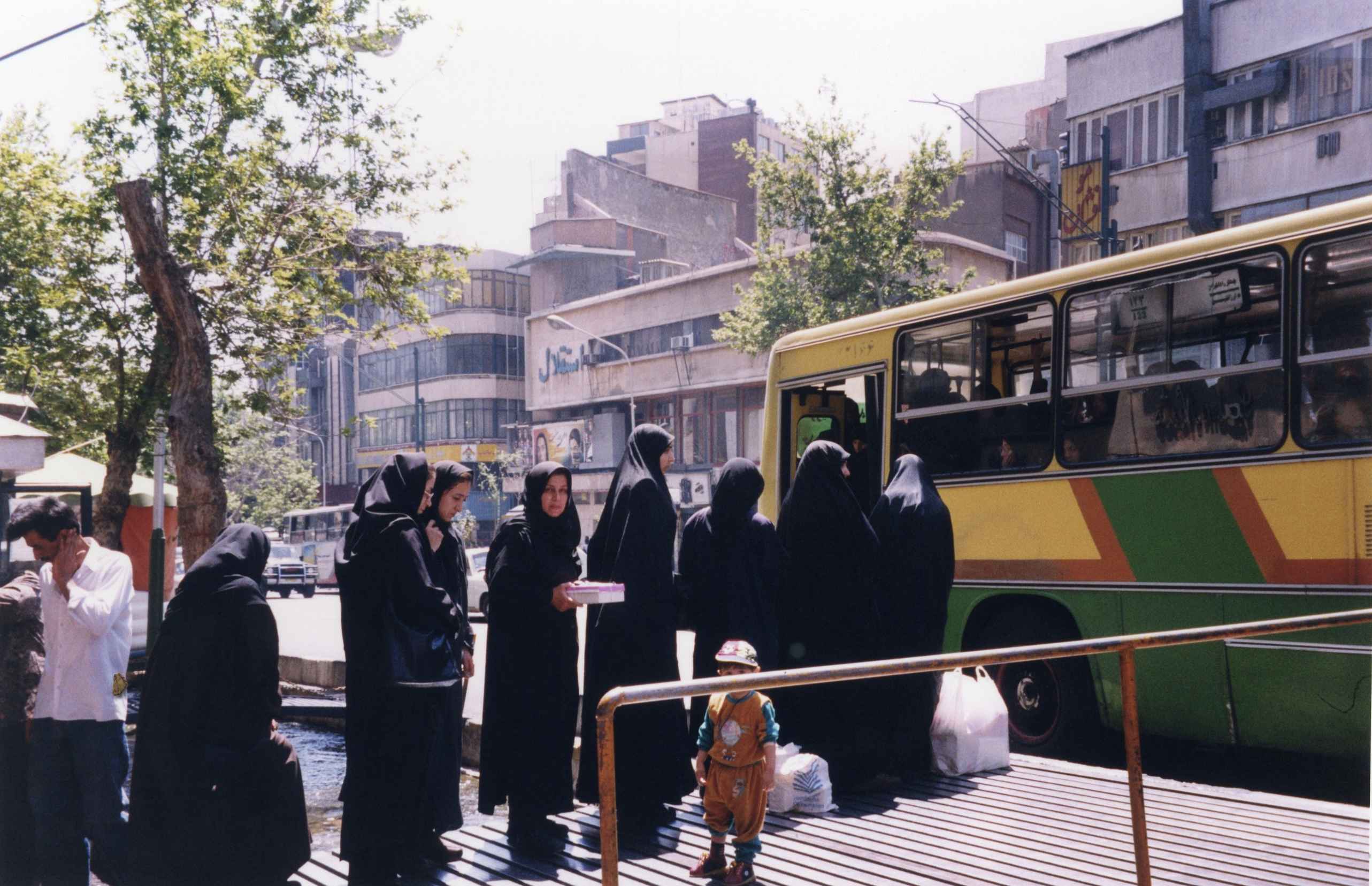
Women in line for the bus, 1999. Photo: from open sources
How was the current landscape of struggles in Iran created by the previous political and socio-economic protests of the 2000’s? What was the local and global context of those struggles?
All that I’ve discussed before, led to a situation in which by the 2000s we had more women university students than men university students. By early 2010s 60% of university students were women. That was a really unexpected outcome of the Islamization. Another issue was that while the Islamic Republic took away the rights that women had under the monarchy, it gave some rights to the women who were willing to follow Islamism, and promote its ideology and its system of organization. Women were second-class citizens, and they had to cover themselves, but at the same time, if a woman followed the system, the system would facilitate her life. They would allow her to work, they would allow her to promote Islamist organizational work.
Many of the children of those women and grandchildren of those women, have now turned against the Islamic Republic and are part of the “Woman, Life, Freedom” movement. Many women have gone to university, are more exposed to the world, and have access to the internet. Iran became more literate after the revolution, because there's the sheer fact that these universities and schools were built, and more people became literate. In addition to Internet access, the growth of translations was another very important development. For the left, the ones that survived, one of the ways that they could contribute was to translate texts from English, German, and French. Philosophical, political and some feminist texts were being translated. Some were being published in a partially censored way, some were being published underground. I myself was involved in co-translating four books on social and political philosophy, including the works of Raya Dunayevskaya, Ukrainian-born Marxist-Humanist philosopher. These books were co-translated with colleagues inside Iran. These were contradictory developments: On the one hand, assault on women, on the other hand - unexpected developments that in some ways opened doors for women. And this is what the women today stand on.
We had the Million Signature Campaign in 2006-2007. Women activists were trying to collect a million signatures to end discriminatory laws against women and to demand basic rights. Rights such as divorce, custody of children, right to travel and work. This campaign was shut down by the government and forced some of its organizers into exile. Then we had the Green Movement, which was a reformist movement protesting against the fraudulent presidential election in 2009. That fraudulent election put a populist and religious fundamentalist man named Mahmoud Ahmadinejad into power. The Green Movement was a mass based moment. It was mostly urban, but it had millions of supporters. It was crushed and the individuals who actually won the election in 2009, were put under house arrest.

Protest in Tehran against the falsified presidential election, June 2009. Photo: from open sources
In 2017, there was a mass uprising against the government. For the first time since 1979, the mass protests were not only urban, but rural also. They had a very strong working class level of participation, and demanded not just reforms, but the overthrow of the regime. They also called for an end to Iran's imperialist interventions in the region: Lebanon, Iraq, and Syria. They called for an end to the Islamic Republic. This was a new stage. At the same time, we also had the movement of women who were going around and standing upon electrical posts and taking off their hijabs and taking pictures of themselves. The day that a woman took off her hijab atop an electrical post in Tehran’s Revolution Avenue, was the day before this 2017 uprising started.
In 2019 there was another mass uprising, again calling for an end to the Islamic Republic and its imperialist interventions. In 2017 and 2019 the demands were not for reforms anymore, but for overthrow. The 2019 uprising was also crushed. In each case, thousands of people were arrested, many were killed, many disappeared, many are still in prison.
The latest uprising was of course the “Woman, Life, Freedom” movement that emerged in September 2022, when the government had started intensifying its assault on women for wearing their hijab loosely. Mahsa Zhina Amini, a young Kurdish woman visiting Tehran, was arrested for not wearing her hijab “properly”. She was beaten viciously in custody, and died in hospital. She wasn’t the only one who was arrested and beaten, and even died for not wearing her hijab “properly”, but she became a symbol of the movement.

